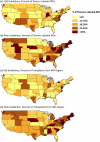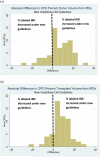Landscape of Deceased Donors Labeled Increased Risk for Disease Transmission Under New Guidelines
- PMID: 26018059
- PMCID: PMC4790457
- DOI: 10.1111/ajt.13356
Landscape of Deceased Donors Labeled Increased Risk for Disease Transmission Under New Guidelines
Abstract
Deceased donors are labeled increased risk for disease transmission (IRD) if they meet certain criteria. New PHS guidelines were recently implemented; the impact of these changes remains unknown. We aimed to quantify the impact of the new guidelines on the proportion of deceased donors labeled IRD, as well as demographic and clinical characteristics. We used Poisson regression with an interaction term for era (new vs. old guidelines) to quantify changes. Under the new guidelines, 19.5% donors were labeled IRD, compared to 10.4%, 12.2%, and 12.3% in the 3 most recent years under the old guidelines (IRR = 1.45, p < 0.001). Increases were consistent across OPOs: 44/59 had an increase in the percent of donors labeled IRD, and 14 OPOs labeled 25% of their donors IRD under the new guidelines (vs. 5 OPOs under the old). African-Americans were 52% more likely to be labeled IRD under the new guidelines (RR = 1.52, p = 0.01). There has been a substantial increase in donors labeled IRD under the new PHS guidelines; it is important to understand the mechanism and consequences to ensure an optimal balance of patient safety and organ utilization is achieved.
Keywords: Donors and donation: donor-derived infections; guidelines; infection and infectious agents; viral: hepatitis C; viral: human immunodeficiency virus (HIV)/acquired immunodeficiency syndrome (AIDS).
© Copyright 2015 The American Society of Transplantation and the American Society of Transplant Surgeons.
Figures



Similar articles
-
Impact of US Public Health Service increased risk deceased donor designation on organ utilization.Am J Transplant. 2019 Sep;19(9):2560-2569. doi: 10.1111/ajt.15388. Epub 2019 May 3. Am J Transplant. 2019. PMID: 30959569 Free PMC article.
-
Deceased organ donor screening for HIV, hepatitis B, and hepatitis C viruses: a survey of organ procurement organization practices.Am J Transplant. 2013 Aug;13(8):2186-90. doi: 10.1111/ajt.12260. Epub 2013 May 24. Am J Transplant. 2013. PMID: 23711196
-
Deceased Organ Donors and PHS Risk Identification: Impact on Organ Usage and Outcomes.Transplantation. 2017 Jul;101(7):1670-1678. doi: 10.1097/TP.0000000000001716. Transplantation. 2017. PMID: 28252560
-
Guidelines for maintenance of adult patients with brain death and potential for multiple organ donations: the Task Force of the Brazilian Association of Intensive Medicine the Brazilian Association of Organs Transplantation, and the Transplantation Center of Santa Catarina.Transplant Proc. 2012 Oct;44(8):2260-7. doi: 10.1016/j.transproceed.2012.07.019. Transplant Proc. 2012. PMID: 23026569 Review.
-
Increased-risk donors and solid organ transplantation: current practices and opportunities for improvement.Curr Opin Organ Transplant. 2020 Apr;25(2):139-143. doi: 10.1097/MOT.0000000000000735. Curr Opin Organ Transplant. 2020. PMID: 32073497 Free PMC article. Review.
Cited by
-
Decline of Increased Risk Donor Offers on Waitlist Survival in Heart Transplantation.J Am Coll Cardiol. 2018 Nov 6;72(19):2408-2409. doi: 10.1016/j.jacc.2018.07.097. J Am Coll Cardiol. 2018. PMID: 30384897 Free PMC article. No abstract available.
-
Consent to organ offers from public health service "Increased Risk" donors decreases time to transplant and waitlist mortality.BMC Med Ethics. 2022 Mar 5;23(1):20. doi: 10.1186/s12910-022-00757-0. BMC Med Ethics. 2022. PMID: 35248038 Free PMC article.
-
Preclinical rationale and current pathways to support the first human clinical trials in cardiac xenotransplantation.Hum Immunol. 2023 Jan;84(1):34-42. doi: 10.1016/j.humimm.2022.07.001. Epub 2022 Jul 15. Hum Immunol. 2023. PMID: 35851182 Free PMC article.
-
Increased Infectious Risk Donor Status and Equity-Relevant Predictors of Organ Donation Organization Approach and Caregiver Consent for Deceased Organ Donation in a Canadian Province (2015-2021).Clin Transplant. 2024 Dec;38(12):e70058. doi: 10.1111/ctr.70058. Clin Transplant. 2024. PMID: 39708307 Free PMC article.
-
Outcomes After Declining Increased Infectious Risk Kidney Offers for Pediatric Candidates in the United States.Transplantation. 2019 Dec;103(12):2558-2565. doi: 10.1097/TP.0000000000002674. Transplantation. 2019. PMID: 30801530 Free PMC article.
References
-
- Grossi PA, Fishman JA. Donor-derived infections in solid organ transplant recipients. Am J Transplant. 2009;9(Suppl 4):S19–26. - PubMed
-
- Rodgers MSR, Lawton KE, Moseley RR. Guidlines for Preventing Transmission of Human Immunodeficiency Virus Through Transplantation of Human Tissue and Organs. Morbidity and Mortality Weekly Report. 1994;43(RR-8):1–18. - PubMed
Publication types
MeSH terms
Grants and funding
LinkOut - more resources
Full Text Sources
Other Literature Sources
Medical

